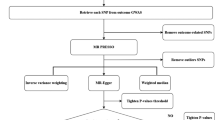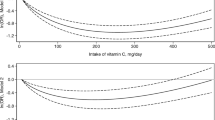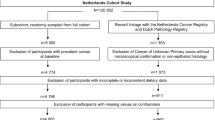Abstract
Purpose
The World Cancer Research Fund/American Institute for Cancer Research identified a probable role for garlic in colorectal cancer prevention based on preclinical evidence and epidemiologic studies, but prospective data are limited. The purpose of this paper was to contribute additional evidence on this topic for men and women in a large prospective cohort study.
Methods
In 1999, 42,824 men and 56,876 women in the Cancer Prevention Study II Nutrition Cohort completed a questionnaire with information on dietary garlic consumption. Garlic supplement use was assessed in 2001. Cox proportional hazards regression was used to estimate multivariable-adjusted hazard rate ratios (HRs) and 95 % confidence intervals (CIs).
Results
During 7 years of follow-up, 579 men and 551 women were diagnosed with colorectal cancer. Among men, daily garlic consumption was associated with a non-significant higher colorectal cancer risk (HR = 1.04, 95 % CI 0.99–1.08 for each additional clove or “4 shakes” of garlic per week), whereas the association was borderline inverse in women (HR = 0.95, 95 % CI 0.91–1.00, p heterogeneity by sex = 0.03). Garlic supplement use was not related to a lower risk of colorectal cancer, and in men, former use was associated with a higher risk of colorectal cancer (HR = 1.85, 95 % CI 1.13–3.03).
Conclusions
These results provide weak support for a role of dietary garlic consumption in colorectal cancer prevention in women, but a possible increased risk in men. Further research is needed to confirm different associations by sex.
Similar content being viewed by others
References
Milner J (2006) Preclinical perspectives on garlic and cancer. J Nutr 136:827S–831S
Knowles LM, Milner JA (2001) Possible mechanims by which allyl sulfides suppress neoplastic cell proliferation. J Nutr 131:1061S–1066S
World Cancer Research Fund/American Institute for Cancer Research (2007) Food, nutrition, and the prevention of cancer: a global perspective. Washington DC AICR
Ngo SNT, Williams DB, Cobiac L, Head RJ (2007) Does garlic reduce risk of colorectal cancer? A systematic review. J Nutr 137:2264–2269
Kim JY, Kwon O (2009) Garlic intake and cancer risk: an analysis using the food and drug administration’s evidence-based review system for the scientific evaluation of health claims. Am J Clin Nutr 89:257–264
Giovannucci E, Rimm EB, Stampfer MJ, Colditz GA, Ascherio A, Willett WC (1994) Intake of fat, meat, and fiber in relation to risk of colon cancer in men. Cancer Res 54:2390–2397
Steinmetz KA, Kushi LH, Bostick RM, Folsom AR, Potter JD (1994) Vegetables, fruit, and colon cancer in the Iowa women’s health study. Am J Epidemiol 139:1–15
Calle EE, Rodriguez C, Jacobs EJ, Almon ML, Chao A, McCullough ML, Feigelson HS, Thun MJ (2002) The American cancer society cancer prevention study II nutrition cohort—rationale, study design, and baseline characteristics. Cancer 94:2490–2501
Bergmann MM, Calle EE, Mervis CA, Miracle-McMahill HL, Thun MJ, Heath CW (1998) Validity of self-reported cancers in a prospective cohort study in comparison with data from state cancer registries. Am J Epidemiol 147:556–562
Calle EE, Terrell DD (1993) Utility of the national death index for ascertainment of mortality among cancer prevention study II participants. Am J Epidemiol 137:235–241
Feskanich D, Rimm EB, Giovannucci EL, Colditz GA, Stampfer MJ, Litin LB, Willett WC (1993) Reproducibility and validity of food intake measurements from a semiquantitative food frequency questionnaire. J Am Diet Assoc 93:790–796
Willett WC, Sampson L, Stampfer MJ, Rosner B, Bain C, Witschi J, Hennekens CH, Speizer FE (1985) Reproducibility and validity of a semiquantitative food frequency questionnaire. Am J Epidemiol 122:51–65
Rimm EB, Giovannucci EL, Stampfer MJ, Colditz GA, Litin LB, Willett WC (1992) Reproducibility and validity of a expanded self-administered semiquantitative food frequency questionnaire among male health professionals. Am J Epidemiol 135:1114–1126
Salvini S, Hunter DJ, Sampson L, Stampfer MJ, Colditz GA, Rosner B, Willett WC (1989) Food-based validation of a dietary questionnaire: the effects of week-to-week variation in food consumption. Int J Epidemiol 18:858–867
Michaud DS, Giovannucci EL, Ascherio A, Rimm EB, Forman MR, Sampson L, Willett WC (1998) Associations of plasma carotenoid concentrations and dietary intake of specific carotenoids in samples of two prospective cohort studies using a new carotenoid database. Cancer Epidemiol Biomarkers Prev 7:283–290
Willett W, Stampfer MJ (1986) Total energy intake: implications for epidemiologic analyses. Am J Epidemiol 124:17–27
Kleinbaum DG, Kupper LL, Muller KE (1988) Applied regression analysis and other multivariable methods. Duxbury Press, Belmont
Sellers TA, Bazyk AE, Bostick RM, Kushi LH, Olson JE, Anderson KE, Lazovich D, Folsom AR (1998) Diet and risk of colon cancer in a large prospective study of older women: an analysis stratified on family history. Cancer Causes Control 9:357–367
Song K, Milner JA (2001) The influence of heating on anti-cancer properties of garlic. J Nutr 131:1054S–1057S
Gardiner P, Graham R, Legedza ATR, Ahn AC, Hisenberg DM, Phillips RS (2007) Factors associated with herbal therapy use by adults in the United States. Alt Ther Health Med 13:22–28
Barnes PM, Bloom B, Nahin RL (2008) Complementary and alternative medicine use among adults and children: United States, 2007. In: National Center for Health Statistics (ed) National Health Statistics Reports. CDC: US Department of Health and Human Services
Tanaka S, Haruma K, Yoshihara M, Kajiyama G, Kira K, Amagase H, Chayama K (2006) Aged garlic extract has potential suppressive effect on colorectal adenomas in humans. J Nutr 136:821S–826S
Satia JA, Littman A, Slatore CG, Galanko JA, White E (2009) Associations of herbal and specialty supplements with lung and colorectal cancer risk in the VITamins and lifestyle study. Cancer Epid Biomarkers Prev 18:1419–1428
Dorant E, van den Brandt PA, Goldbohn RA (1996) A prospective cohort study on the relationship between onion and leek consumption, garlic supplement use and the risk of colorectal carcinoma in The Netherlands. Carcinogenesis 17:477–484
Conflict of interest
The authors declare they have no conflict of interest.
Author information
Authors and Affiliations
Corresponding author
Electronic supplementary material
Below is the link to the electronic supplementary material.
Rights and permissions
About this article
Cite this article
McCullough, M.L., Jacobs, E.J., Shah, R. et al. Garlic consumption and colorectal cancer risk in the CPS-II Nutrition Cohort. Cancer Causes Control 23, 1643–1651 (2012). https://doi.org/10.1007/s10552-012-0042-7
Received:
Accepted:
Published:
Issue Date:
DOI: https://doi.org/10.1007/s10552-012-0042-7




